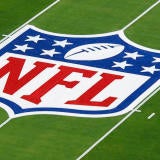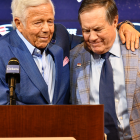There are very few sure things in sports. The Patriots winning the AFC East is one example of a sure thing. LeBron James making the NBA Finals when playing for an Eastern Conference team is another. Tom Brady giving the Patriots a hometown discount on his contract is also one.
Brady turns 42 in August. Immediately following the Patriots' Super Bowl LIII victory, Brady quickly confirmed that he wasn't retiring. He has been steadfast in his insistence that he is going to play into his mid-40s.
In the days leading up to the Super Bowl, Patriots owner Robert Kraft said he envisions Brady as remaining New England's quarterback for quite awhile. When asked by reporters about Brady's contract, Kraft said he didn't have any reservations about extending the four-time Super Bowl MVP's deal beyond 2019. Kraft didn't seem overly concerned about Father Time catching up to Brady. The Patriots have played in the last three Super Bowls, coming away with two victories.
Brady is entering the final year of his contract. He is scheduled to make $15 million, which consists of a $14 million base salary and $1 million of 46-man per-game active roster bonuses ($62,500 each game).
Brady's leverage
Brady will have quite a bit of leverage in any discussions about a new contract if he chooses to use it. His $27 million cap number is the NFL's fifth highest for 2019. The Patriots have $177.67 million of 2019 salary-cap commitments under offseason cap accounting rules, where the top 51 salaries (i.e. cap numbers) matter, according to NFLPA data. There's $3.173 million of unused cap room being carried over to the upcoming league year. With the NFL's preliminary projections putting the 2019 salary cap between $187 million and $191.1 million, the Patriots could use the cap relief that would come with a Brady extension.
Brady playing out his contract while continuing to keep Father Time at bay would put the Patriots in a precarious position because there isn't any kind of succession plan in place at quarterback. The Patriots would have to designate Brady as a franchise player or run the risk of some team that considered itself a quarterback away from being a championship contender making him a lucrative short-term offer in free agency. It would cost the Patriots $32.4 million to put a franchise tag on Brady in 2020 under the 20 percent increase over the prior year's salary (typically cap number) provisions for this designation.
Why Brady won't use his leverage
Brady started taking a rather unique approach to his contracts in 2013, when he first renegotiated the 2010 extension which made the NFL's highest-paid player at $18 million per year. He began consistently giving the Patriots hometown discounts instead of driving the market.
Brady's third renegotiation since signing the 2010 deal, which was in March 2016, added two years for $41 million running through the 2019 season. This 2016 renegotiation covered four years for a total of $60 million. The new money in Brady's multiple contract maneuvers, compared to what he would have gotten had he played out his 2010 contract -- which was set to expire after the 2014 season -- is $71 million over five new contract years for an average of $14.2 million per year.
Brady has been a tremendous bargain during this time. The following 10 quarterbacks have made more than Brady from their NFL contracts since he started taking less than his market value in 2013:
1. Aaron Rodgers ($155,312,250)
2. Matthew Stafford ($127,529,470)
3. Joe Flacco ($124,024,525)
4. Matt Ryan ($123,785,630)
5. Drew Brees ($123,258,385)
6. Eli Manning ($113.65 million)
7. Philip Rivers ($108,830,015)
8. Ben Roethlisberger ($105,709,470)
9. Alex Smith ($100,017,380)
10. Cam Newton ($88,438,640).
Brady is at $85,794,781.
Signing-bonus deferrals were taken into account in the calculations. Otherwise, Ryan is second because $23.25 million of the $46.5 million signing bonus he received from the Falcons last May -- when he signed a five-year, $150 million contract extension -- isn't payable until the middle of April. Brees would be right behind Manning if $12 million of the $37 million signing bonus from his 2012 deal wasn't paid in January 2013. The Collective Bargaining Agreement's daily amounts for participating in a team's voluntary off-season workout program are included in the calculations.
The NFLPA probably hasn't been happy with Brady's willingness to undercut the market with his contracts but would never express a negative opinion publicly about arguably the greatest football player of all-time. The approach has paid dividends for Brady in allowing the Patriots to assemble a more talented roster than they would have otherwise, which has resulted in three more Super Bowl rings since starting the process. The only two quarterbacks among the 10 listed above that have been to Super Bowls during this span are Ryan and Newton. Both lost in their lone appearance.
Brady hasn't started a trend among upper-echelon quarterbacks with the discounted contracts -- although 39-year-old Drew Brees gave the Saints a financial break for the first time in his numerous contract dealings with the franchise last offseason. There's a good chance Brees could have become the NFL's first $30 million player on a short-term deal with a willingness to exploit his leverage by exploring potential options with teams instead of limiting negotiations to just the Saints. He signed a two-year, $50 million contract with $27 million fully guaranteed to remain in New Orleans. The fully guaranteed amount equals Brees' 2018 salary.
Brady reportedly wanted a new contract last offseason; $5 million of incentives that required Brady to perform at an MVP level were added to his contract during the preseason because he has been such a bargain. There were 20 quarterbacks who were either clear-cut starters or took the most snaps for their respective teams last season on veteran contracts. Brady's $20.5 million average yearly salary ranked 16th among the 20 veterans.
The incentives were considered likely to be earned because Brady reached the statistical achievements in 2017. In order to keep Brady's salary-cap number -- the NFL's 12th highest in 2018, at just over $22 million -- the same, because of the how the incentives were classified, $10 million of his 2018 base salary was converted to signing bonus so it could be prorated over 2018 and 2019.
Brady had a laundry list of performance milestones where he could have earned $1 million for each of the first five met, provided his offensive playtime was at least 70 percent and he threw a minimum of 224 passes. The specific milestones were top five in NFL passer rating, top five in completion percentage, top five in yards per pass attempt, top five in touchdown passes, top five in passing yards, and each of the five categories paired with the Patriots winning the Super Bowl where Brady had 70 percent or more offensive playtime during the postseason. Since the $5 million of incentives were considered likely to be earned, the Patriots will get a salary-cap credit in 2019 equal to that amount because Brady didn't hit any of the performance milestones.
Current quarterback market
Knowing that it's extremely unlikely Brady will exploit his leverage, it's just matter of how big of a discount he'll give the Patriots. Quarterback salaries have exploded since Brady's 2016 renegotiation. Nine quarterbacks have signed long-term deals averaging more than Brady's $20.5 million since Brady's extension in March 2016.
The top of the quarterback market increased by almost 25 percent during 2018, with multiple quarterbacks taking turns as the NFL's highest-paid player. The 49ers got the ball rolling by signing Jimmy Garoppolo, who used to be Brady's backup, to a five-year extension averaging $27.5 million per year last February after only five impressive starts -- following a midseason trade from the Patriots -- rather than designate him as a franchise player. Kirk Cousins received the NFL's first lucrative fully-guaranteed veteran contract averaging $28 million per year ($84 million over three years) from the Vikings at the start of free agency. Ryan became the NFL's first $30-million-per-year player last spring. Rodgers raised the bar with his preseason extension averaging $33.5 million per year.
The amount fully guaranteed at signing jumped by more than 60 percent. The benchmark before Ryan's $94.5 million was Matthew Stafford at $60.5 million in the five-year, $135 million extension the Lions gave him in 2017, which made the NFL's highest-paid player at $27 million per year.
The fully-guaranteed approach
It may make sense for Brady to pursue a fully-guaranteed contract running through the 2022 season when he is 45, since it's practically a given he is going to take a discount. Brady getting the second lucrative veteran contract that's completely secure could help set the stage for other high-profile players to follow in his footsteps in this regard. Kraft should receptive to the concept unless he was only giving lip service to the idea of Brady being with the Patriots for the foreseeable future.
Using Brady's current $20.5-million-per-year average from his 2016 contract extension as a guide, the new contract could like look the following:
Signing Bonus: $30 million ($7 million with two weeks of execution; $8 million payable on Nov. 17; $15 million payable on 3/31/20)
Fully Guaranteed At Signing: $76.5 million
New Money Total: $61.5 million ($76.5 million over four years)
Contract Length: Three-year extension
Average Per Year: $20.5 million
| Year | Base salary | Signing bonus proration | Salary cap number | Cash flow |
|---|---|---|---|---|
2019 | $1,500,000 | $19,500,000 | $21,000,000 | $16,500,000 |
2020 | $17,500,000 | $7,500,000 | $25,000,000 | $49,000,000 |
2021 | $15,000,000 | $7,500,000 | $22,500,000 | $64,000,000 |
2022 | $12,500,000 | $7,500,000 | $20,000,000 | $76,500,000 |
All four years would be guaranteed for skill, injury and salary cap; no offset.
The signing-bonus payment schedule mirrors Brady's 2016 extension. The salary guarantees not having offsets is consistent with Brady's contracts negotiated in 2010, 2013 and 2014. This is significant because a player receives his salary from the team that releases him in addition to the full salary from his new contract with another club when there isn't an offset (also known as "double dipping"). An offset clause allows a team to reduce the guaranteed money owed to the player if released by the amount of his new deal with another team.
The Patriots would pick up $6 million of 2019 cap room with the renegotiated contract. The cap numbers in the other three years are manageable. The biggest one is 2020 at $25 million. Brady would be taking up a decreasing percentage of New England's salary cap as the deal progressed because of expected cap increases and Brady's salary dropping by $2.5 million in each of the last two years. The decreasing salary and cap numbers would help guard against Brady declining as a player.
Should Brady retire before the contract expires, the Patriots would be protected with the same language that's in his 2016 extension. Retirement was among the numerous defaults listed that would have triggered Brady's guarantees voiding.
The salary de-escalator model
Either the $25-million-per-year average of Brees' current contract with the Saints or Garoppolo's $27.5 million average yearly salary could be used as a baseline if the Patriots aren't amendable to a fully-guaranteed contract. Brees, who turned 40 last month, could be an appropriate benchmark, since he's also defying the odds by playing at a high level when most quarterbacks have already retired. Adjusting Brady's current $20.5 million average to the expected salary cap increase would mean an extension in the $25-million-per-year range. Brady would also be justified in insisting on an extension average comparable with his former backup's.
The de-escalator concept is seldom used in NFL contracts outside of a few teams tying a small amount of salary to participation in the offseason workout program. This type of de-escalator is being borrowed from Adrian Peterson's 2015 renegotiation with the Vikings. Peterson's 2015 performance and Minnesota's success determined his 2016 salary. His $5 million third-day-of-the-2016-league-year roster bonus decreased by $1 million because he rushed for fewer than 1,550 rushing yards and the Vikings didn't win a playoff game. The roster bonus would have decreased by another $1 million if Peterson hadn't rushed for at least 1,350 yards and the Vikings had missed the playoffs. Peterson had a chance to earn back the $1 million as an incentive in 2016 at the same performance threshold that triggered the decrease.
Below is chart illustrating a potential contract between Brady and the Patriots with this concept.
Signing Bonus: $25 million (($7 million with two weeks of execution; $8 million payable on Nov. 17; $10 million payable on 3/31/20)
Guaranteed Money: $47.5 million
Fully Guaranteed At Signing: $47.5 million
New Money Total: $82.5 million ($97.5 million over four years)
Contract Length: Four-year extension
Average Per Year: $27.5 million
| Year | Base salary | Signing bonus proration | Salary cap number | Cash flow |
|---|---|---|---|---|
2019 | $2,500,000 | $18,250,000 | $20,750,000 | $17,500,000 |
2020 | $20,000,000 | $6,250,000 | $26,250,000 | $47,500,000 |
2021 | $25,000,000 | $6,250,000 | $31,250,000 | $72,500,000 |
2022 | $25,000,000 | $6,250,000 | $31,250,000 | $97,500,000 |
2019 and 2020 would be guaranteed for skill, injury and salary cap; no offset.
2021-2022 base salary de-escalator
Brady's base salary decreases by $1 million for each of the regular-season performance milestones added as incentives for 2018 that aren't met in the previous season (i.e.; 2020 for 2021 and 2021 for 2022). $1 million of the de-escalation will be extinguished with each postseason milestone achieved. The unachieved performance milestones that caused the decrease become incentives for that year. To further clarify, if Brady's 2021 salary decreased by $5 million because he didn't reach any of the milestones, he would have the opportunity to make the money back as incentives in 2021.
The de-escalator protects New England from age finally catching up to Brady. If Brady statistically ranked where he did with the categories in 2018 for each of the last three years, the maximum de-escalation would apply. His best rankings in 2018 were seventh with 4,355 passing yards and 10th with 29 touchdown passes. Brady would make $72.5 million in new money by playing out the contract to bring the extension average down to $24,166,666.
There hasn't been much deviation from the signing bonus payment schedule with the fully-guaranteed concept. New England has more flexibility with this model, although the $31.25 million cap numbers in 2021 and 2022 are significantly higher than in fully guaranteed contract. The deal could be exited after 2020 without any further payment to Brady where there's a $12.5 million cap charge relating to the signing bonus proration from the last two years.
Final thoughts
The Patriots should be extremely grateful that Brady hasn't used the contract leverage he's possessed when he's had the chance. Ideally, Brady would exploit his leverage in any upcoming contract discussions by using the franchise-tag prospect against the Patriots to get the best possible deal. That's simply not going to happen unless Brady reverses course and approaches his negotiations like Brees always did before last offseason, which would be a major surprise. The de-escalation concept wouldn't even be a suggestion except for Brady's penchant to constantly leave money on the table.





















